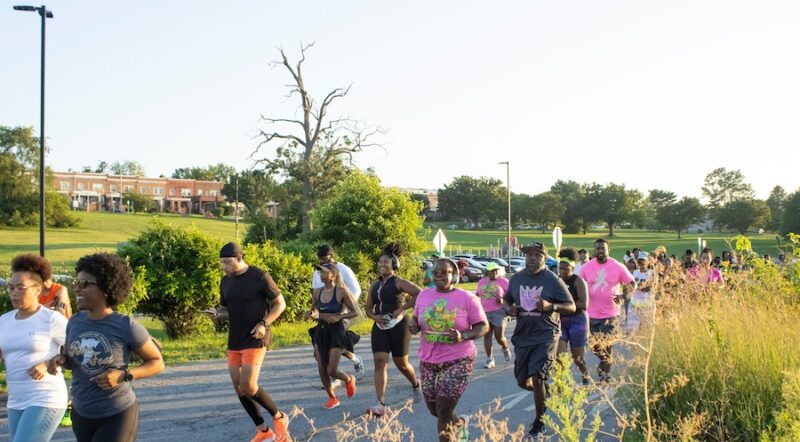Elements of Gold: Michigan’s Pere Marquette Rail-Trail Is a Special Place for All Seasons
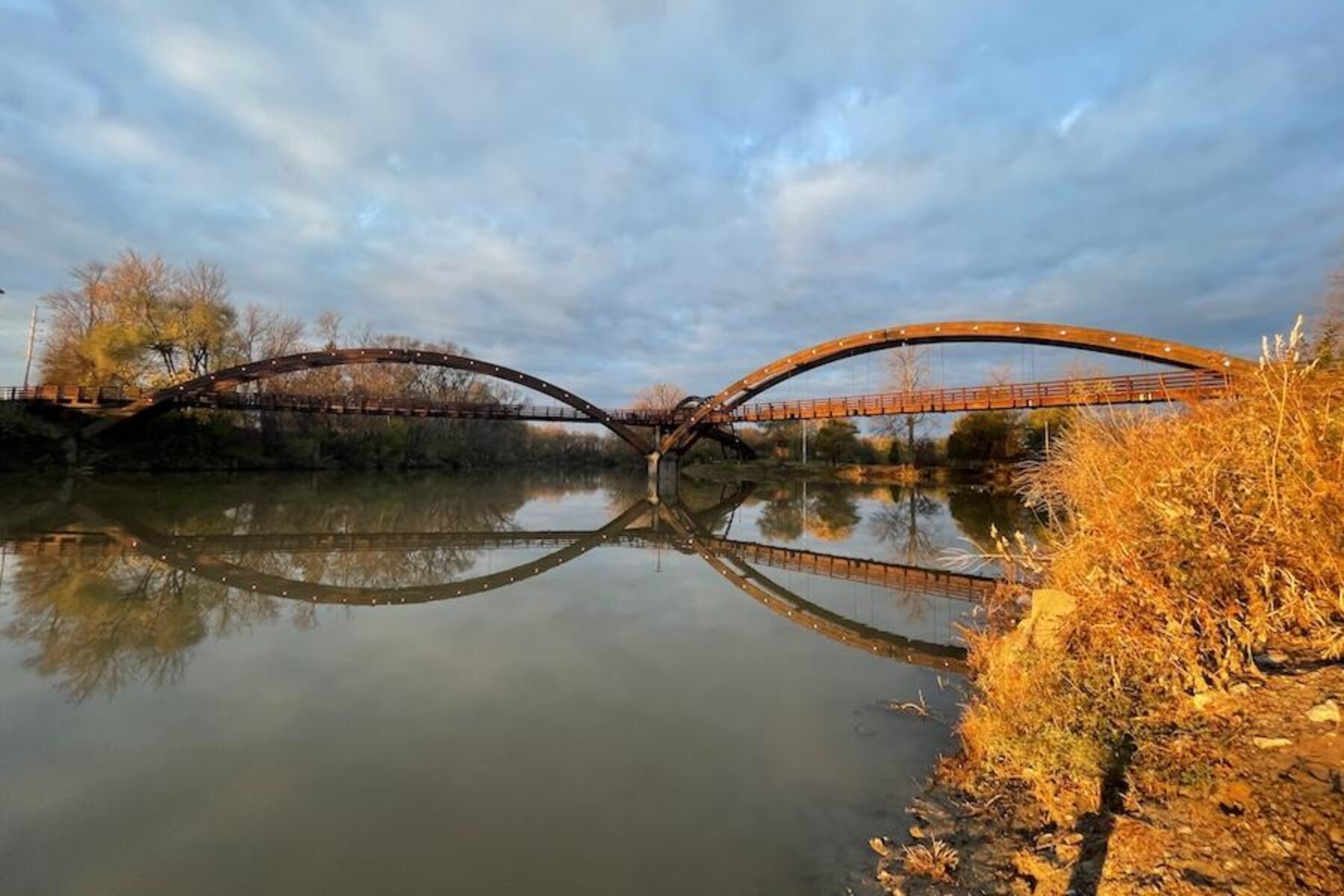
“The Pere Marquette is like a gold standard, in my opinion, for the quality of the trail and the upkeep. This is something that people can enjoy all the time.”
—Brad Alvesteffer, Owner, Ray’s Bike Shop
As the rising sun broke through on an overcast mid-November Michigan morning, a group of four women convened in Midland’s Chippewassee Park parking lot for a brisk Saturday run. The temps were in the mid-30s, but the frigid dew point had toes curling in this city about a half-hour west of the southern lip of Saginaw Bay.
That didn’t stop Shelley Hobbs, Ann Simanskey, Mara Stewart and Morgan Schieber from bundling up and meeting at the easternmost point of the Pere Marquette Rail Trail for a 4-mile run—followed, importantly, by coffee. It was Veterans Day weekend, and the LED lights lining the three 180-foot-long spokes of Midland’s aptly named Tridge—a renowned bridge feature of the Pere Marquette—glowed red, white and blue, all reflecting in the confluence of the Chippewa and Tittabawassee rivers below it.
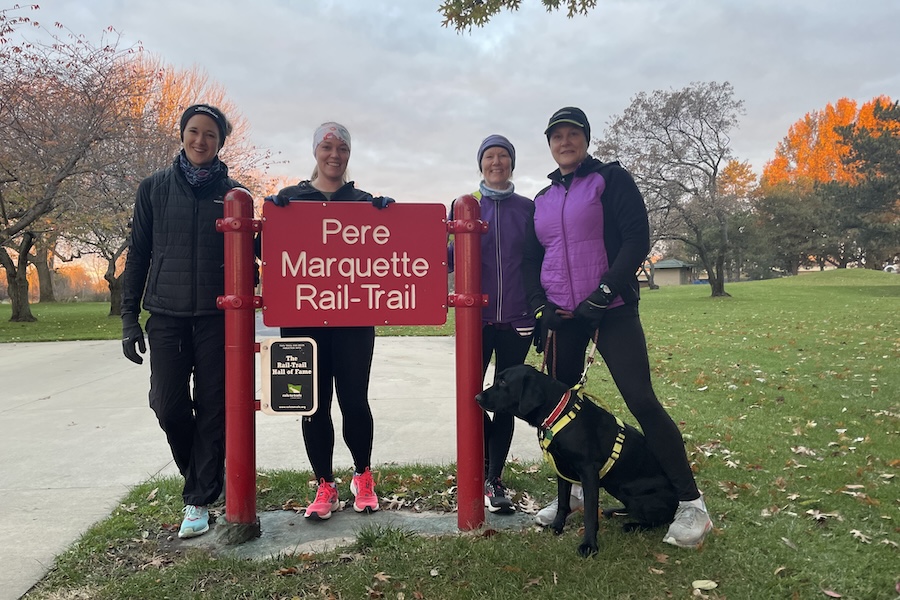
The Pere Marquette Rail Trail is a golden asset for Central Michigan. It features unique trailside attractions, a 14-foot-wide pathway that is maintained year-round, and a 30-year legacy of strong community support. Learn more.
Counties: Clare, Isabella, Midland
Mileage: 30
Uses: Walking/running, biking, wheelchair accessible, inline skating, fishing, horseback riding, cross-country skiing
A Rails to Trails Conservancy Hall of Fame trail, the Pere Marquette Rail Trail is a path for all seasons—with maintenance that makes it viable for year-round use.
Starting steps from the Tridge and running northwest from Midland to Clare, the Pere Marquette Rail Trail follows 30 miles of the former Flint and Pere Marquette Railroad line. The trail’s corridor passes through the rural hamlets of Sanford, Coleman and Loomis. Between towns, towering poplars form a protective wall between people on the trail and car traffic on the adjacent Saginaw Road, which is good. Because a driver could be forgiven for confusing the Pere Marquette, a 14-foot-wide, paved asphalt path, with a state highway lane.
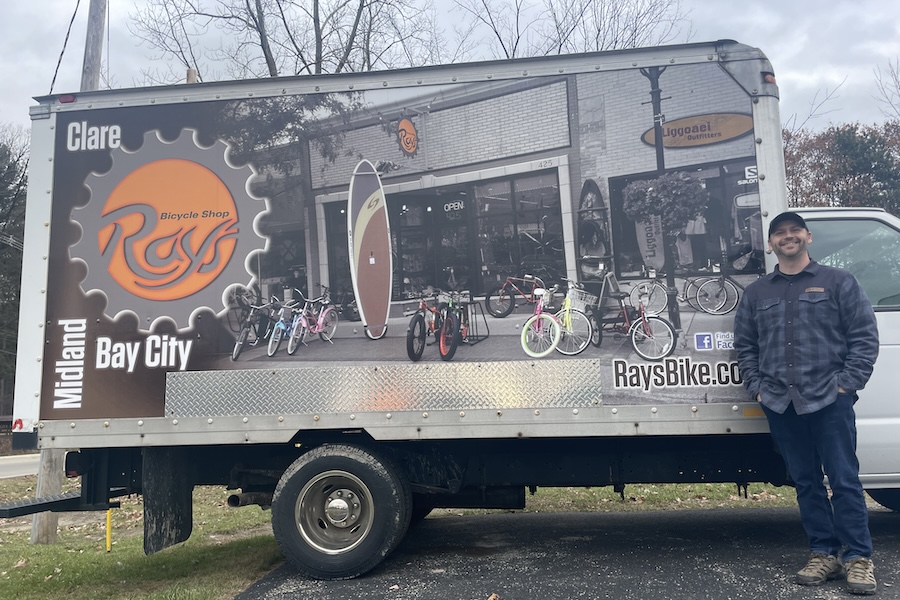
“That trail is so smooth and well maintained,” said Brad Alvesteffer, owner of Ray’s Bike Shop, a local institution with shops in Midland, Clare and Bay City. “The Pere Marquette is like a gold standard, in my opinion, for the quality of the trail and the upkeep. They even plow it in the wintertime. This is something that people can enjoy all the time.”
About half of the trail in total gets plowed during these wintertime months. This includes the 10-mile stretch through Midland, which passes the Herbert H. Dow Historical Museum, the Northwood University campus and more, out to Sanford.
Hobbs, the secretary of Friends of the Pere Marquette Rail Trail, said that her pre-dawn, wintertime runs with running partner Ann Beck have sometimes coincided with the City of Midland plow crew’s first pass at clearing the trail.
Hobbs has the icy-faced selfies to prove it.
The unplowed half doesn’t lack for use in the meantime. Alvesteffer, who worked his way up to owner of Ray’s Bike Shop over a 20-year career there, said the Midland shop was among the first in the country to stock fat-tire bikes. Locals use them to maneuver along the region’s vast network of on- and off-road trail offerings no matter the weather.
The Pere Marquette is maintained by local governments, including the City of Midland, and Midland, Clare and Isabella counties. Friends of the Pere Marquette Rail Trail partners with all of them to keep the trail in top shape, thanks in part to support from local foundations and individuals alike.
“We have extremely giving people,” said Hobbs, who makes a weekly visit to the nonprofit’s P.O. box to pick up rail-trail membership checks and donations. Often, contributors will write on their checks sums hundreds of dollars larger than the $20 annual individual fee.
Those contributions fund trail-related purchases provided to the management agencies, from the trail’s signature Pere Marquette-labeled red windsocks that adorn pavilions along the path, to mile markers, to utility vehicles, to an asphalt crack sealer.
“It just highlights not only the spirit of the community, but … the philanthropic nature of this area,” said Mark Maxwell, president of Friends of the Pere Marquette Rail Trail.
Vision of What Became
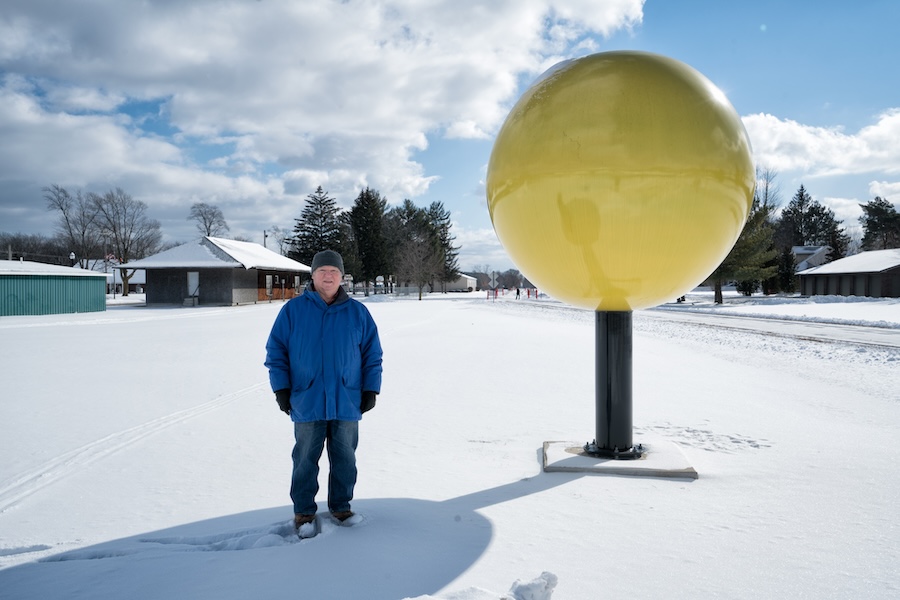
Run or Bike the Solar System
No matter the weather, the sun is always out in Coleman along the Pere Marquette Rail Trail. A 90-inch-diameter sculpture of the sun starts off a set of solar system sculptures that are proportionally sized and distanced from the sun. From Mercury in Coleman to Pluto, which is 5.6 miles away in the Village of North Bradley, you experience the cosmos at a 600 millionto-1 scale on the trail.
As with many decades-old rail-trail projects, some residents along the Pere Marquette’s proposed path initially greeted the proposal with suspicion or outright hostility.
During a 30th-anniversary celebration last summer, Sharon Mortensen, president and CEO of the Midland Area Community Foundation (MACF), read quotes from naysayers who’d written to the Midland Daily News in the early 1990s. One in particular said motorcycle gangs should have to buy their own territory.
That, Mortensen said, was fortunately not the prevailing mindset. Bill Gibson, a former Midland County Parks and Recreation director, advocated for the former rail line to become a trail as early as 1987. In 1990, the MACF paid $246,000 for the first section of rail that would become the Pere Marquette Rail Trail. Spanning downtown Midland about 3 miles to Dublin Road, it opened three years later to wide public acclaim.
“I think it was just this core of very dedicated people that saw the vision of what could be,” Mortensen said, regarding the early years.
Hobbs, 64 and a lifelong Midlander, remembers the years before the trail’s segments were added. While Midland-based Dow Chemical Company drew top chemical engineers and other skilled workers to live in the round by Central Midland area, there weren’t many visitors. As a kid, she could pedal up to Dow Gardens and ask the caretaker if she could explore the majestic grounds. Nowadays, it takes a ticket. Hobbs said one of the reasons Midland has become a destination is the Pere Marquette Rail Trail.
“It brings people from all over,” she said. “We get a lot of folks from surrounding states that will come and use the trail.”
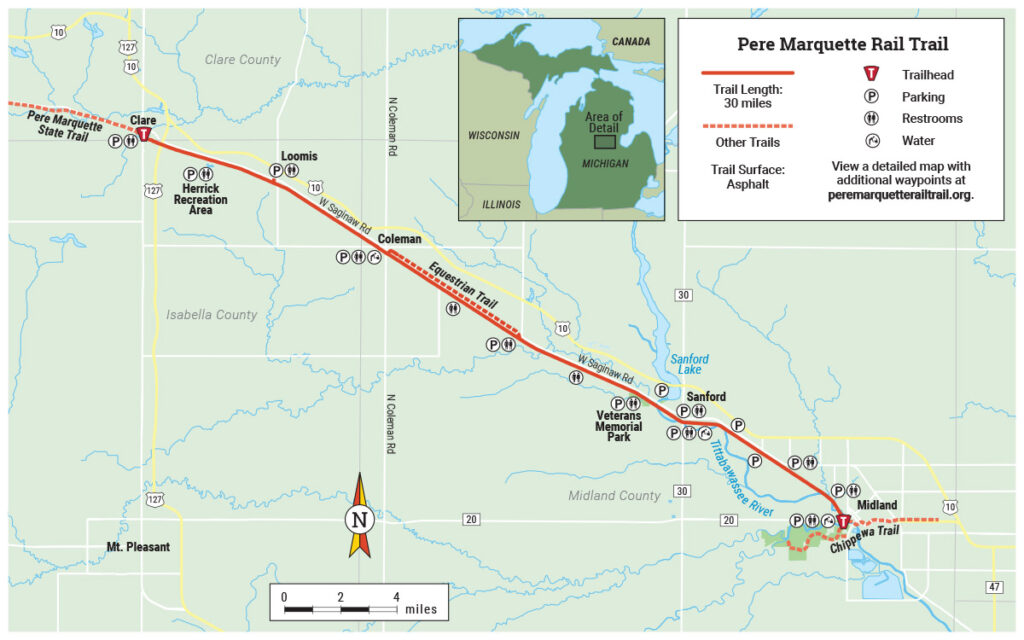
Hobbs’ running group partner Stewart, 33 and a fellow Midlander, always had the Pere Marquette available to her growing up. But the trail’s quality didn’t register to the degree it now does until she left home for school. There, she basically had a track to train on.
“Coming back, I realized what an asset that it was to the community, and I’ve been running it ever since,” said Stewart, who now serves on the Friends of the Pere Marquette Trail board.
While the MACF made the initial land purchase, Mortensen said the foundation had strong community backing from the outset, which continues to this day.
There was funding and support from city, state and federal sources. Additional contributions came from the Herbert H. and Grace A. Dow Foundation, the Charles J. Strosacker Foundation, the Rollin M. Gerstacker Foundation, the Midland Lions Club and others. In concert with the land acquisition, Mortensen said the foundation set up an endowed fund that’s still going strong. When she checked its assets in November, it held about $2 million.
“It generates about 5% of that on an annual basis,” she said. “And that goes into just [generating] spendable dollars to be pulled when needed to help with repairs and so on.”
The endowment has served as a key source of matching funds for grants that require them, Mortensen said. Over the years, the 3-mile trail has expanded to 30. The trail segment overseen by Midland County is now the park department’s most heavily used park. It’s popularity is noted among a trove of options that offer forests, beaches, pools, playgrounds, and mountain bike and BMX courses.
Credit for the Pere Marquette Rail Trail’s destination reputation goes at least in part to its colossal width, its supporters say. But current board members aren’t entirely certain who deserves the credit for thinking big decades ago. Some theorized it was a product of the times, at the height of the early-1990s inline skating craze. Fourteen feet was wide enough to swing your arms and skate side by side.
Long-time Pere Marquette trail user Shelley Schoenherr traces the generous width to the late Carl Gerstacker, a former Dow Chemical Company board chairman, and his wife, Esther. They carried on the charitable legacy of his parents at the Gerstacker Foundation. The foundation has supported major projects in Midland, from senior housing to construction of the Tridge and early investments in the Pere Marquette Rail Trail.
The way Schoenherr heard it is that Gerstacker asked his wife how wide it should be, and Esther said 14 feet. “He always gives that credit to his wife,” she said.
Whatever the case, the wide path makes passing a bigger breeze than any wind rolling off nearby Lake Huron.
Howard’s Ride
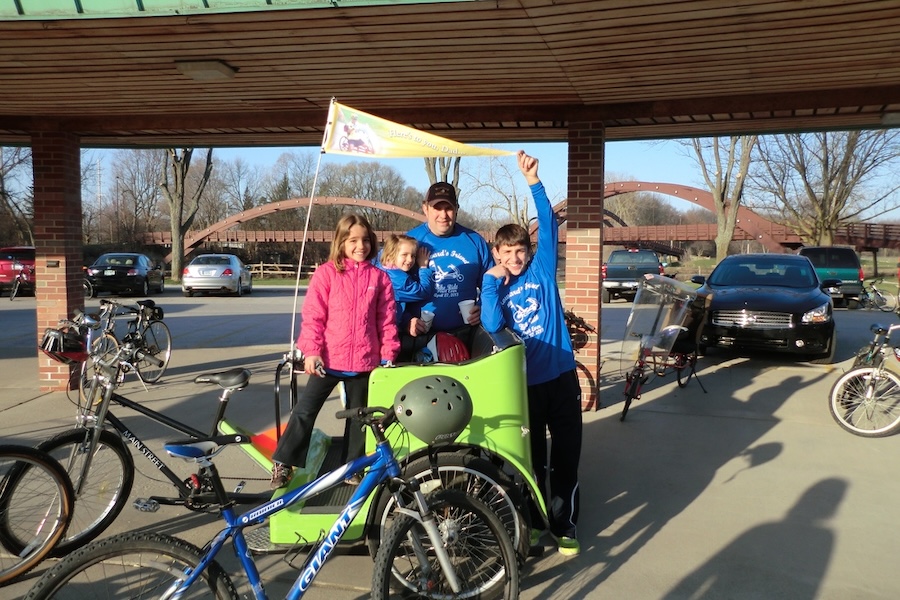
For his 80th birthday in December 2012, Shelley Schoenherr’s father, Howard, had wanted to celebrate with an 80-mile bike ride. It would’ve started on the Pere Marquette Rail Trail, a project he and his wife, Barbara, supported since its conceptual stage.
Barbara, a Midland County Parks and Recreation board member who passed away in 2022, never ran or rode the trail a day in her life, Shelley Schoenherr, said. Howard, on the other hand, put in thousands of miles biking it every year. On his 60th birthday, he had convinced three of his five kids, Shelley included, to go on a ride across Michigan. One sibling dropped out after a day. “And then the next year, I was the only one foolish enough to show up,” she said.
So an 80-mile, late-December ride for the longtime Sanford resident would have normally been in his wheelhouse, had it not been for the lymphoma. “It came on very quickly,” Shelley Schoenherr said.
As he underwent treatment, Shelley offered a compromise: They’d go on the ride, but not in the cold on his Dec. 27 birthday. They agreed to ride instead on April 27, 2013. Howard Schoenherr died in September of 2012; his obituary mentioned he was most at peace when he was physically active and invited contributions in his honor to be made to Friends of the Pere Marquette Rail Trail.
A few months after the funeral, Shelley Schoenherr pulled up a note on her phone she’d saved about that April 27 ride and got inspired. “I called up a couple of his friends and said, ‘Hey, you want to do 80 miles for my dad’s 80th birthday?’ And pretty soon, we’d made it into a bike ride.’”
And even sooner, she had calls from people who’d heard about the bike ride from one of the friends she’d invited. They’d say, “Well how do I get to be Howard’s friend?”
All of a sudden, Shelley Schoenherr was a bit of an event organizer. “Eighty of us rode the first ride,” she said. Every spring since, she has traveled 140 miles from her Fair Haven home to host the Howard’s Friend Bike Ride, a fundraiser for Friends of the Pere Marquette Rail Trail. She’s joined on ride day in Midland by hundreds of participants who sign up for 5- to 60-mile rides. These days, the Howard’s Friend Bike Ride takes place entirely on the Pere Marquette. The next Howard’s Friend ride is set for May 4, 2024.
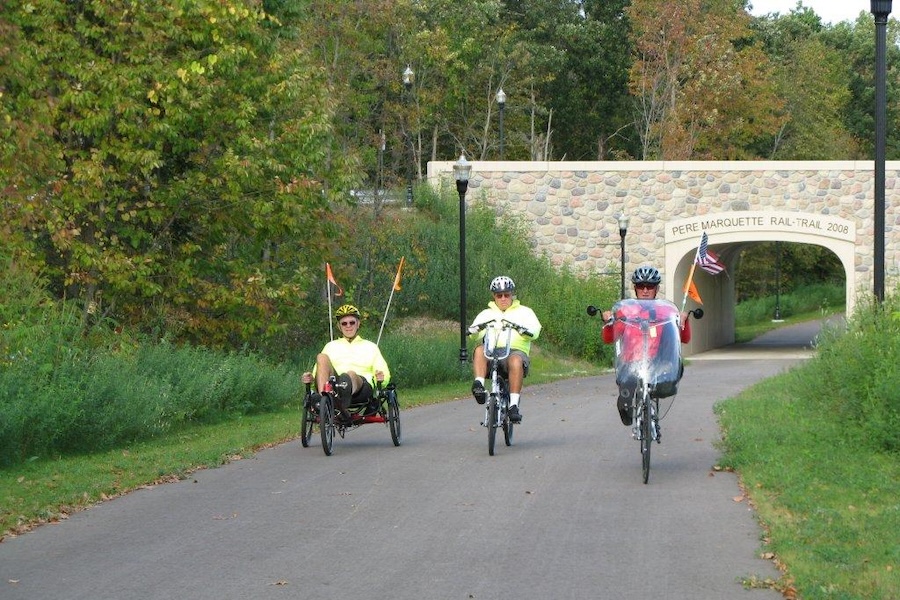
“Dad said he wanted two things [if a ride was made in his honor],” Shelley Schoenherr said. “He wanted the race to be affordable to everybody, so it’s still only 30 bucks to ride the ride. And he wanted kick-ass shirts. We do long-sleeve microfiber tees with that $30. You don’t have to pay extra. We have somebody provide breakfast. We have food at Sanford, Coleman, Clare—and you can get it on the way back too. It’s made to be an event.”
And she said a race dedicated to him could only take place on the Pere Marquette Rail Trail.
“Because it was special to my dad,” she said. “And because we rode it from the first time they took the railroad ties up to his last bike ride.”
Connecting the Pere Marquette Trails
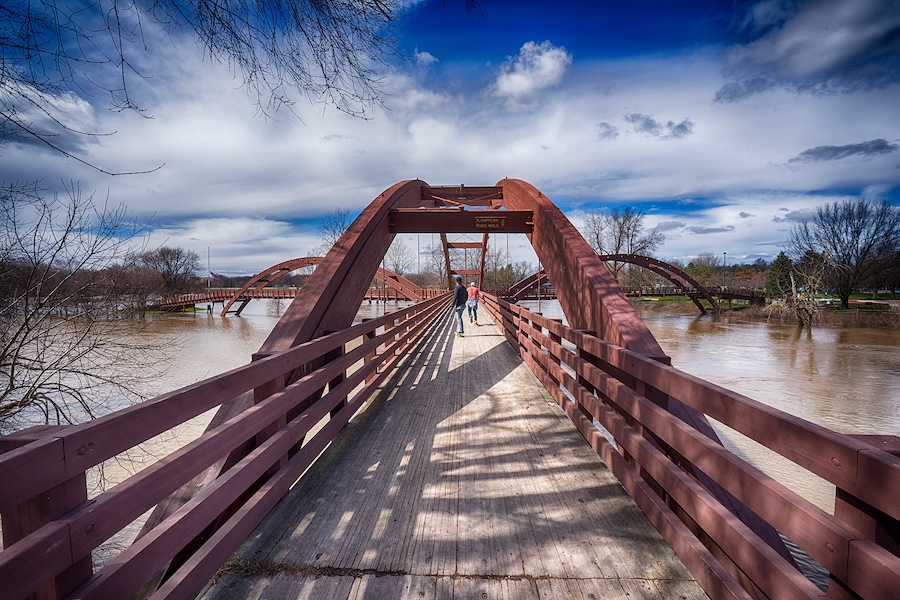
To get to 80 miles, the first Howard’s Friend ride required cyclists to hop on roads in Clare for a little over 2 miles to reach the starting point of the Pere Marquette State Trail. The connection was enough of a burden that Schoenherr decided to keep riders protected on the Pere Marquette Rail Trail on future rides.
Now, funds are in place to bridge the Clare gap and connect to the Pere Marquette State Trail. The 53-mile east–west crushed limestone path from Clare to Baldwin is operated by the Michigan Department of Natural Resources. Construction is tentatively scheduled to begin in spring 2024.
“We provided a $20,000 gift to the fund to help support that, because obviously it’s one of those things that our users really have asked for and will appreciate once it’s done,” Maxwell of Friends of the Pere Marquette Rail Trail said. “We provided that last year, and the history behind that is that this has been talked about for a long, long time. But it looks like it’s finally going to happen.”
Flooding Resiliency on the Pere Marquette Rail Trail
When Shelley Hobbs and I were walking in Midland on the Pere Marquette Rail Trail on a section alongside the Tittabawassee River, she pointed to a home where crews were in the process of lifting it to a higher flood-protection elevation. To me, it seemed impossibly far from the water’s edge. But in the spring of 2020, the Tittabawassee rose up 34 feet during a devastating 500-year flood.
It left thousands of Sanford- and Midland-area residents displaced and caused approximately $175 million in damages across Midland County. Sanford, with a population around 800, “was really just completely devastated,” Mark Maxwell, president of Friends of the Pere Marquette Rail Trail, said.
Maxwell said the punishing waters that rushed downriver following a series of dam breaches tore out about a third of a mile of the trail in Sanford. Riders had to bypass that rebuild for a few years, but it’s back online. Emergency management funds addressed the bulk of those costs, while local agencies and volunteer groups took the lead on clearing debris, including boats, refrigerators and toppled dumpsters, that had been swept onto the path.
The trail from the Tridge to Northwood University was underwater in downtown Midland. Somewhat miraculously, Maxwell said, there were no repairs needed to the asphalt surface once the waters receded. He attributes the Pere Marquette Rail Trail’s swift recovery to the investments made in it three decades prior.
They Stop in the Winter, Right?
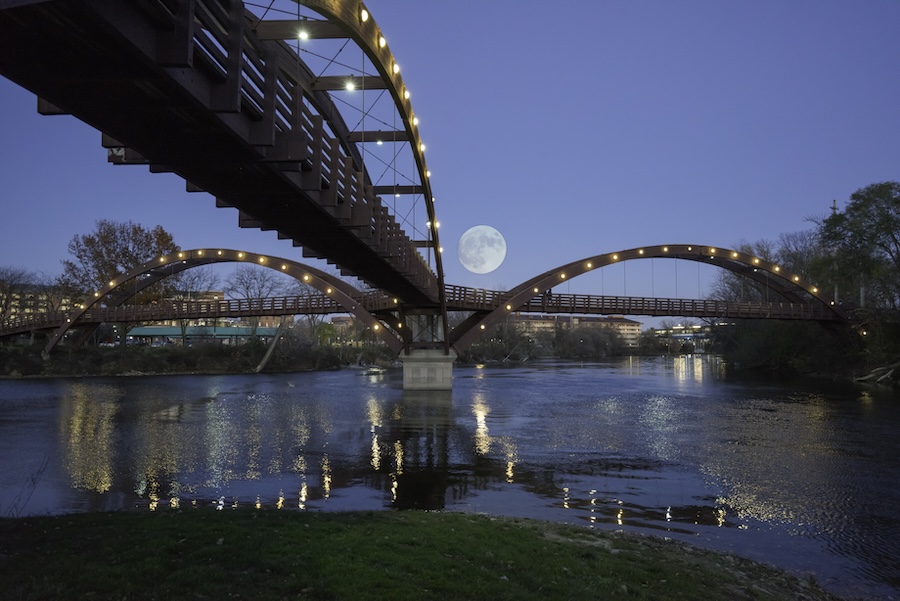
After their brisk Veterans Day 4-miler, Hobbs, Stewart and Schieber shed some layers and sat down at Espresso Milano in downtown Midland.
In the spring, summer and fall months, the Pere Marquette Rail Trail and Midland’s many outdoor offerings are bustling. The H Hotel downtown offers loaner bikes to guests through an agreement with Ray’s Bike Shop, which also has a shop in Clare at the other end of the trail. The Midland Brewing Company overflows with trail users, as does the seasonal Cottage Creamery.
Getting out on the trail during those months made all the sense in the world to Schieber, 24, who had joined the running group only a few weeks before I visited Midland. A longtime treadmill runner, Schieber said she marveled at the peaceful experience of putting miles in on the Pere Marquette when she first started in October.
“And then I was like, ‘They stop in the winter, right?’” she said, and looked over to Hobbs. “She’s like, ‘No.’”
Schieber spent a good portion of that November run asking Hobbs about sock preferences.
It can be brutal, Hobbs admitted, especially at the start, with the northwest winds whipping at you. But you power through it, Stewart said.
“I’ve never felt more like a beast though when we’re running and it’s cold, and when you’re done, your eyelashes are frozen,” Stewart said.
Regarding the socks, Hobbs said she swears by Smartwools. And when it comes to how to layer for a run, there are rules. Hobbs’ long-time running buddy Beck created these:
- 60 degrees and up: Sleeveless tank top.
- 50s: Short-sleeve shirt.
- 40s: Long-sleeve shirt.
- 30s: Tank and long-sleeve.
- 20s: Two long-sleeves.
- 10s: Two long-sleeves and a jacket!
Gloves get added in the 30s. Your headband changes from light to winter style in the 30s. You put on a necker in the 40s. And there’s one more rule: No matter the temperature, you just show up, Hobbs and Stewart both told Schieber. The trail will be there for you. And then you get coffee.
This article was originally developed for the Winter 2024 issue of Rails to Trails magazine. It has been reposted here in an edited format. Subscribe to read more articles about remarkable rail-trails and trail networks while also supporting our work. Have comments on this article? Email the magazine.

Donate
Everyone deserves access to safe ways to walk, bike, and be active outdoors.



